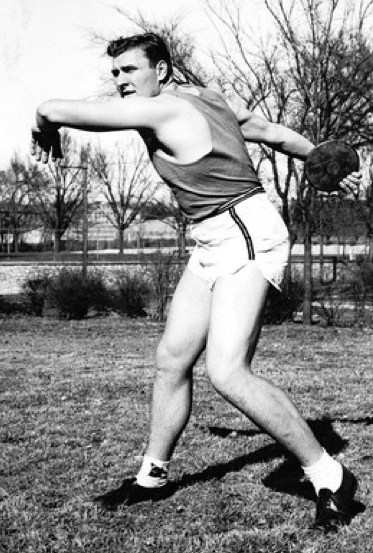Bill Bangert dies at 87; masters track pioneer from the 1960s
Here’s the Wall Street Journal’s profile of Bill that appeared Tuesday:
By STEPHEN MILLER
Bill Bangert was an outsized man with dreams to match.Mr. Bangert, who died July 12 at age 87, held national titles in the shot put and discus. He boxed and—for relaxation—practiced throwing a caber, a 20-foot wooden pole that weighed roughly 175 pounds.
But he was frustrated in the pursuit of his biggest dream: bringing the Olympics back to St. Louis for the first time since 1904.
He founded the town of Champ, Mo.,—population 12— in the late 1950s to be the site of a shopping complex, horse racetrack, 7,500-room hotel and a giant domed stadium to host the Games. But the governor vetoed the $200 million bond issue needed to fund his vision.
Mr. Bangert—who stood 6 feet, 5 inches and weighed 265 pounds—won NCAA discus and shot-put championships in 1944 and 1945 while attending the University of Missouri.
At age 28, he was struck blind by a rare malady and yet continued to compete, placing second in the shot put at a national championship in 1952. He was later partially cured with experimental therapy that restored sight in one eye.
Wherever Mr. Bangert competed, organizers also tried to display the musical talents of the man known as “the Singing Samson.” At a boxing match in Boston he sang the national anthem, then was knocked out cold by his heavyweight opponent.
He impressed during an audition for New York’s Metropolitan Opera, though he begged off further training when told he would have to learn foreign languages.
In the late 1950s, he began to dream of hosting the Olympics and founded Champ on suburban St. Louis farmland. Later, he pursued his bond issue in the state legislature.
“On a patriotic issue like this, everyone ought to buy them,” Mr. Bangert told The Wall Street Journal in 1967.
After more than a decade spent on the project, Mr. Bangert declared bankruptcy and moved to Anaheim, Calif., throwing himself more than ever into music and athletics, including a new-found passion, Highland Games.
In 1971, while visiting Scotland for caber-throwing championships, he carried the 775-pound Dinnie Stones over a bridge spanning the River Dee in Potarch, becoming the first person to accomplish the feat since famed strongman Donald Dinnie did it himself in 1860. The prize was a gallon of malt whiskey, conferred by the Lord Provost of Aberdeen.He followed this feat with an even more spectacular one in 1973, dragging the 2.5-ton Naha Stone in Hawaii, which supposedly qualified him to rule as king.
Mr. Bangert later became a stalwart of master’s track and field tournaments across the country.
He and his wife joined the Crystal Cathedral choir and appeared on TV’s “Hour of Power,” an evangelical show.In 1991, the Verizon Wireless Amphitheater opened not far from the spot where he had envisioned his Olympic stadium, and Mr. Bangert pronounced himself pleased with his prescience.
“I found out a long time ago you have to lose before you can become a real champion,” he told the Riverfront Times in St. Louis.






2 Responses
A blog post from Brian Oldfield about Bill:
http://brianoldfield.com/wordpress/?p=91
Our National T&F Champs were held in St. Louis in 1963. I was with the Striders and we flew in on a chartered Super Connie. The track was a black shredded-rubber surface. Bob Hayes ran a 9.1 hundred on it TWICE. Awesome. Bangert may have had something to do with that track. We loved it. Smartty
Leave a Reply